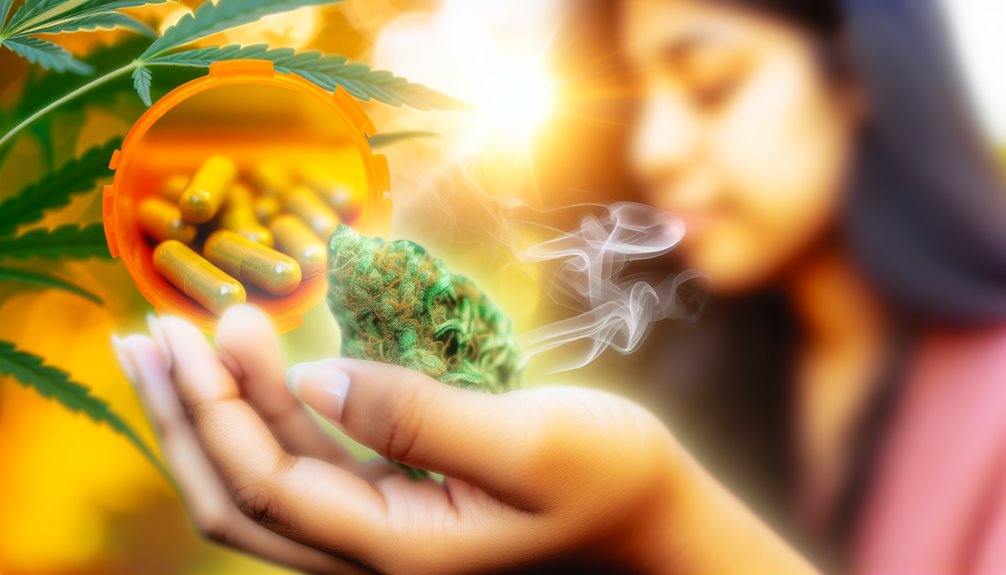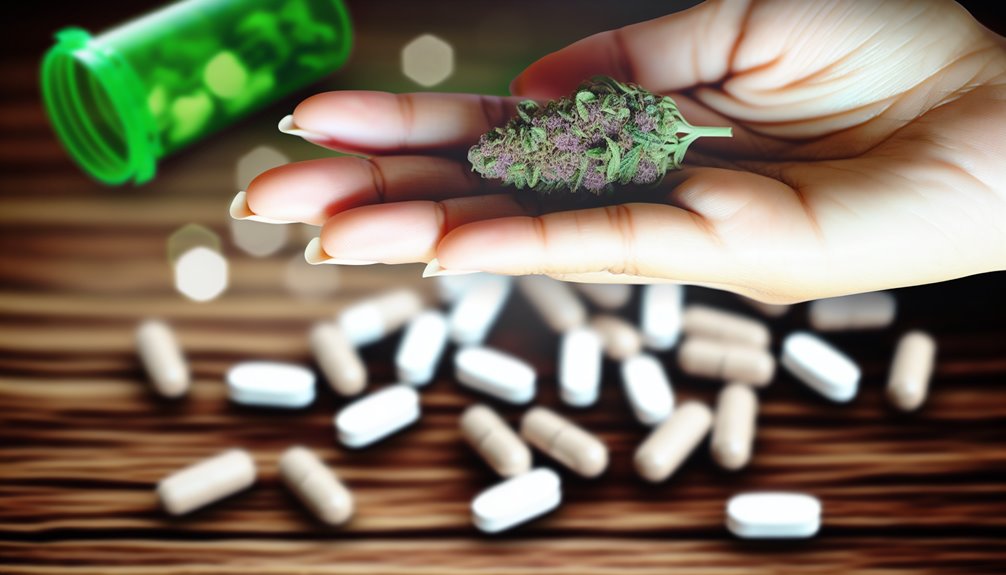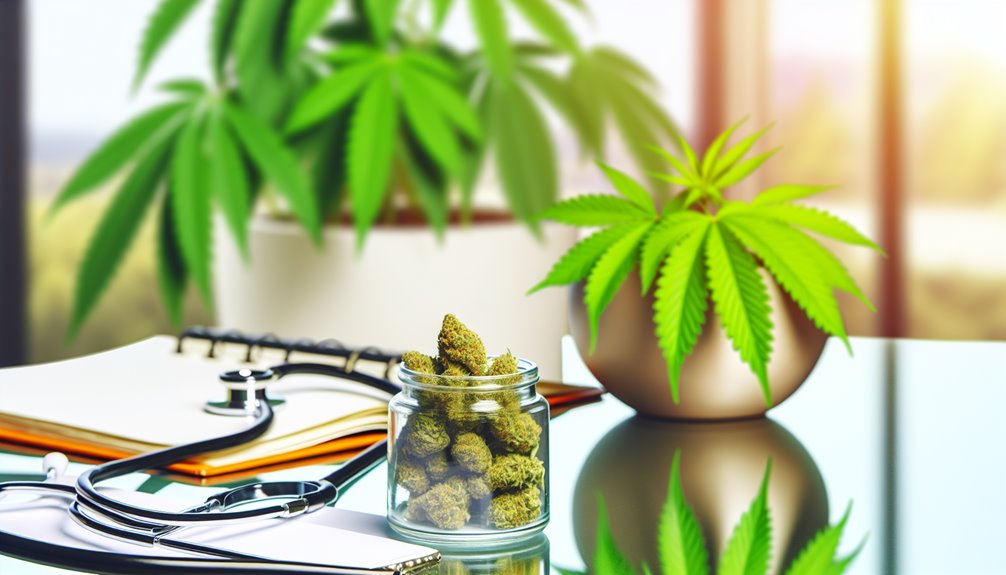Have you considered the potential of medical marijuana in addressing the rampant opioid crisis? As an alternative solution, it's gaining attention due to its ability to mimic the analgesic effects of opioids, but with fewer side effects and a lower risk of addiction. Testimonials and clinical studies show significant improvements in pain management and quality of life. While the legal landscape still varies across states, this natural, holistic approach to pain relief seems promising. Interested? There's more to discover.
Understanding the Opioid Crisis in America

While the opioid crisis in America has been escalating for years, its effects have become alarmingly apparent. The opioid epidemic has skyrocketed, with overdose deaths peaking at 81,806 in 2022. This alarming statistic represents a tenfold increase over the past 25 years. States like West Virginia are particularly hard-hit, with the highest overdose rate in the nation. The economic impact is staggering, with the U.S. economy losing an estimated $1.5 trillion in 2020 due to healthcare costs, lost productivity, and criminal justice activities. The crisis began in the 1990s, evolving through three distinct waves, each characterized by a different type of opioid. To combat this crisis, government and legal responses have ramped up, investing billions in treatment programs. Despite these efforts, the crisis persists, affecting all communities and leading to significant disparities in healthcare access and treatment. The crisis, which has seen a significant increase in the use of fentanyl since 2013, has become a major public health concern.
Medical Marijuana: What It Is and How It Works
Understanding medical marijuana requires an exploration into the world of cannabinoids, the active chemicals present in the *Cannabis sativa* plant. Your journey begins with THC and CBD, the main chemicals used in medicine. THC influences mood and consciousness, while CBD has different, non-psychoactive effects. These cannabinoids interact with your body's endocannabinoid system, causing various effects based on consumption methods. You might smoke or vaporize for quick effects, eat it in food for delayed but lasting relief, or use topical forms for localized benefit. Despite its healing properties, it's important to note that medical marijuana, while legal in 38 states, three territories, and D.C. as of 2023, remains illegal under federal law. Remember, each variety of marijuana contains varying amounts of cannabinoids, making effects unpredictable. As you serve others using medical marijuana, understanding these cannabinoid interactions and consumption methods is essential.
The Science Behind Medical Marijuana and Pain Relief

Delving into the science behind medical marijuana and pain relief, we find that cannabinoids, such as THC and CBD, are the main players. They interact with your endocannabinoid system, specifically CB1 and CB2 cannabinoid receptors, to modulate pain and inflammation.
Here's how it works:
- Cannabinoids bind to receptors on brain and nerve cells, slowing pain impulses and easing discomfort.
- THC, acting as a partial agonist at CB1 receptors, provides analgesia and sedation.
- The endocannabinoid system, with endocannabinoids like anandamide and 2-AG, plays a vital role in pain modulation.
- Cannabinoids also offer anti-inflammatory effects, contributing to pain reduction.
Clinical trials show that cannabinoids can provide relief from pain, similar to codeine, and even reduce opioid use. Further research could reveal more about this promising alternative to opioids.
Comparing the Side Effects: Opioids vs. Medical Marijuana
When considering the side effects associated with opioids and medical marijuana, the differences are striking. Opioids often cause constipation, nausea, and even life-threatening respiratory depression. Additionally, opioids can lead to physical dependence and increased tolerance, necessitating higher doses for effective pain management. In contrast, medical marijuana's side effects are generally milder, including dizziness and dry mouth. Most importantly, it presents less risk of physical dependence and addiction. This side effects comparison makes medical marijuana an appealing opioid alternative. However, it is important to recognize the need for more research to fully understand cannabis's efficacy and side effects. As a service to those seeking less harmful pain relief options, the medical community must continue exploring these opioid alternatives.
Case Studies: Success Stories of Medical Marijuana for Pain Management

Consider the numerous case studies that demonstrate the success of medical marijuana in pain management. Patient testimonials illustrate this clearly, with many reporting significant pain reduction. It's more than just anecdotal evidence; studies back it up:
- A meta-analysis of 49 RCTs confirmed cannabis's efficacy in reducing pain.
- Many patients prefer cannabis to opioids for its fewer side effects and better symptom management.
- Cannabis has shown promise in managing specific conditions, such as multiple sclerosis and fibromyalgia.
- Despite potential risks like cognitive dysfunction and psychosis, the benefits often outweigh the drawbacks for those struggling with chronic pain.
These case studies are just a snapshot of the potential of medical marijuana. It's important to continue exploring this alternative, especially for those who've found little relief elsewhere.
Legal Status of Medical Marijuana in Different States
Traversing the complex landscape of medical marijuana legislation can be an intimidating task, especially given the variation in legal status across states. In states like California and Oregon, medical marijuana is fully legal with generous possession limits for patients. However, states like Arizona and Arkansas have mixed status, allowing limited possession and stricter state regulations. Georgia, Idaho, and Indiana, on the other hand, have decriminalized but not fully legalized marijuana, mostly limiting usage to low-THC CBD oil. Then there's Alabama and Hawaii with stricter regulations, emphasizing patient rights and their ability to possess only specific amounts. Your ability to access medical marijuana as an alternative to opioids largely depends on your state's stance, making it essential to understand the legislative landscape.
Medical Professionals' Views on Medical Marijuana as an Alternative to Opioids

Understanding your state's stance on medical marijuana is only one piece of the puzzle; it's also important to grasp what medical professionals think about it as an alternative to opioids for pain relief. There's been a notable decrease in opioid prescriptions in states where medical marijuana is legal. Medical professionals recognized the efficacy of medical marijuana in reducing pain and improving functionality. However, they emphasize the need for more research and express concern about potential dependency.
- States with legalized medical marijuana show lower opioid prescription trends.
- Medical marijuana efficacy is notable in pain reduction and functionality improvement.
- Some healthcare providers express concern over potential dependency.
- There's a call for more research into the potential benefits and risks of medical marijuana.
These insights are key to understanding the evolving dialogue around this alternative pain relief option.
Patient Perspectives: Experiences With Medical Marijuana for Pain Relief
As you explore alternatives to opioids for pain relief, it is crucial to take into account patient testimonials and experiences with medical marijuana. Patient testimonials indicate a significant average pain reduction, with cannabis effectiveness high in managing musculoskeletal conditions. Most patients prefer medical cannabis over opioids due to fewer side effects and better symptom control. Their quality of life improves as pain reduces, and social life, activity levels, and concentration increase. Medical cannabis allows for better management of chronic conditions like fibromyalgia and back pain. Many patients reported consistent sleep patterns and normalization of testosterone levels. Dosage adjustments are often necessary, but once set, patients experience long-lasting relief. Consequently, medical cannabis presents a viable alternative to opioids for pain management.
Conclusion
You've explored the opioid crisis, understood medical marijuana's workings, and weighed the pros and cons. You've seen real-life success stories and heard both professional and patient perspectives. It's clear, marijuana isn't just smoke and mirrors. It's a viable pain relief option, a light in the tunnel of the opioid crisis. It's not a magic bullet, but it's a step towards a pain-free existence with fewer side effects and less addiction risk. That's worth considering, isn't it?
If you're curious to learn more about how medical marijuana can help with pain relief, I warmly invite you to visit Fells Point Cannabis Docs of Maryland. You can also give us a call at (410) 401-4200. Our friendly team is here to answer your questions and guide you through the process. Let's explore how we can support your journey towards a more comfortable life!
